

|
|
Δείτε εδώ τα πιο πρόσφατα μηνύματα από όλες τις περιοχές συζητήσεων, καθώς και όλες τις υπηρεσίες της AcroBase. H εγγραφή σας είναι γρήγορη και εύκολη. |
|
|||||||
|
 |
|
|
Εργαλεία Θεμάτων | Τρόποι εμφάνισης |
 |
#3586
|
 |
|
||||
|
Discover the cosmos! Each day a different image or photograph of our fascinating universe is featured, along with a brief explanation written by a professional astronomer. 2016 July 22 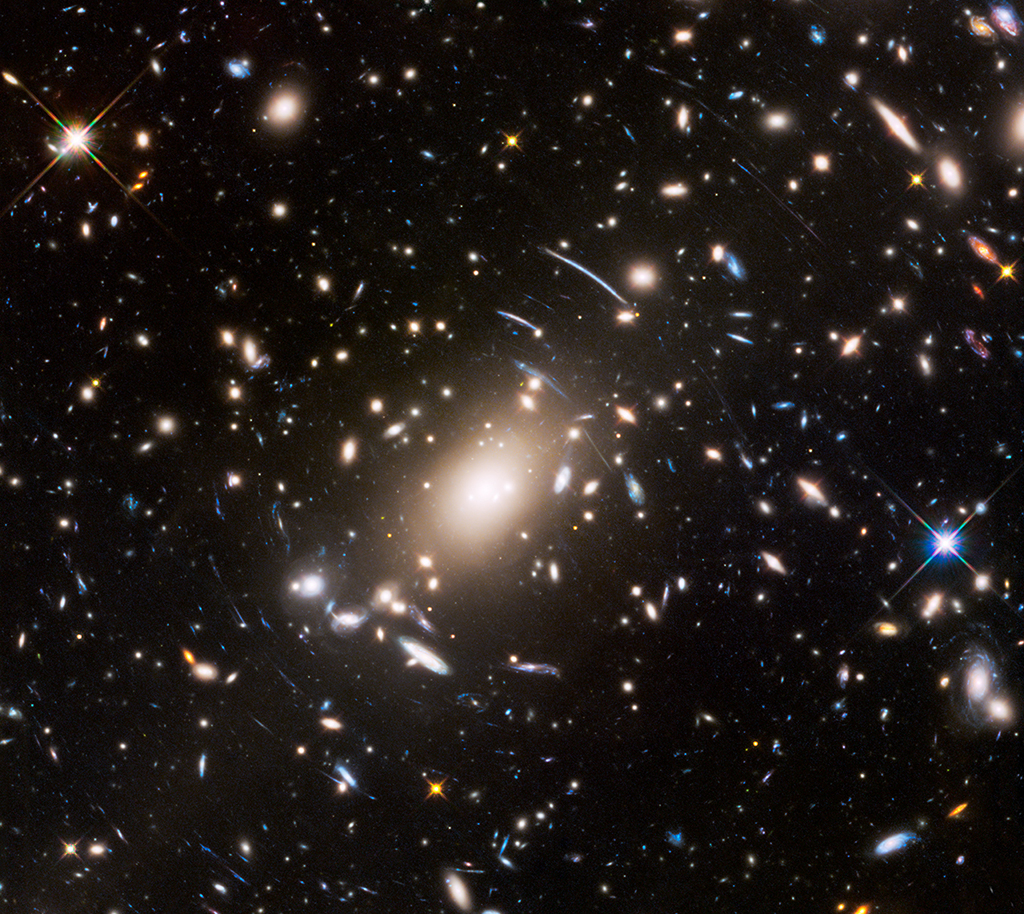 Image Credit: NASA, ESA, Jennifer Lotz (STScI) Explanation: Some 4 billion light-years away, galaxies of massive Abell S1063 cluster near the center of this sharp Hubble Space Telescope snapshot. But the fainter bluish arcs are magnified images of galaxies that lie far beyond Abell S1063. About twice as distant, their otherwise undetected light is magnified and distorted by the cluster's largely unseen gravitational mass, approximately 100 trillion times the mass of the Sun. Providing a tantalizing glimpse of galaxies in the early universe, the effect is known as gravitational lensing. A consequence of warped spacetime it was first predicted by Einstein a century ago. The Hubble image is part of the Frontier Fields program to explore the Final Frontier. Tomorrow's picture: pixels in space
__________________
όταν γράφεται η ιστορία της ζωής σου, μην αφήνεις κανέναν να κρατάει την πένα |
| Οι παρακάτω χρήστες έχουν πει 'Ευχαριστώ' στον/στην Xenios για αυτό το μήνυμα: | ||
maralin (23-07-16) | ||
 |
#3587
|
 |
|
||||
|
Discover the cosmos! Each day a different image or photograph of our fascinating universe is featured, along with a brief explanation written by a professional astronomer. 2016 July 23 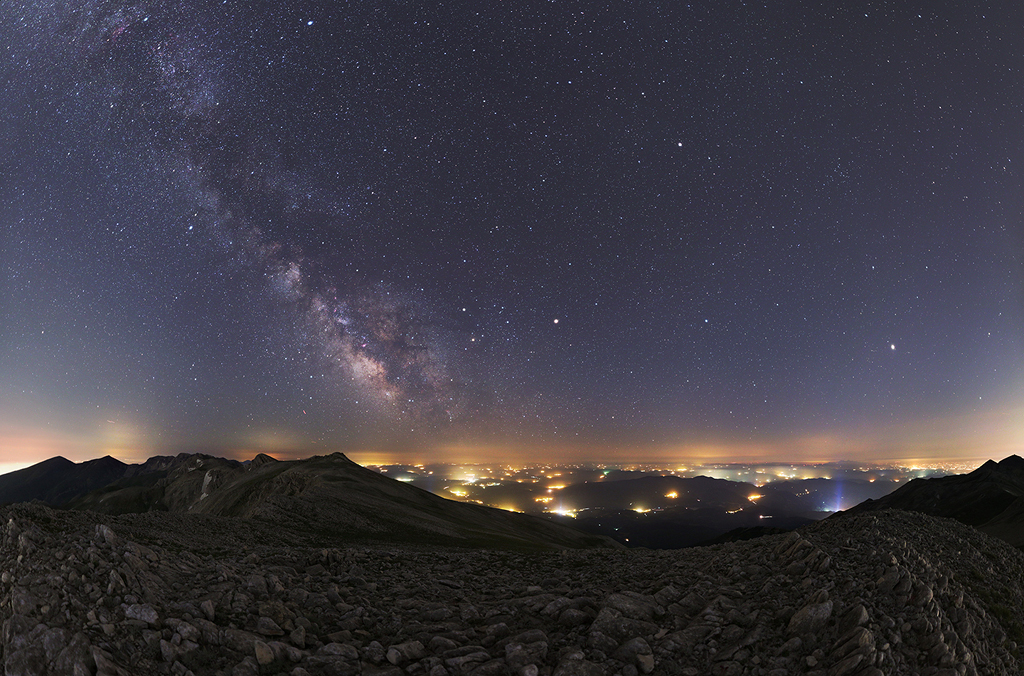 Image Credit & Copyright: Tunç Tezel (TWAN) Explanation: Lights sprawl toward the horizon in this night skyscape from Uludag National Park, Bursa Province, Turkey, planet Earth. The stars and nebulae of the Milky Way are still visible though, stretching above the lights on the northern summer night while three other planets shine brightly. Jupiter is at the far right, Mars near the center of the frame, and Saturn is just right of the bulging center of our galaxy. Because the panoramic scene was captured on July 6, all three planets pictured were hosting orbiting, operational, robotic spacecraft from Earth. Popular Mars has five (from three different space agencies): MAVEN (NASA), Mars Orbiter Mission (India), Mars Express (ESA), Mars Odyssey (NASA), Mars Reconnaissance Orbiter (NASA). Ringed Saturn hosts the daring Cassini spacecraft. Just arrived, Juno now orbits ruling gas giant Jupiter.
__________________
όταν γράφεται η ιστορία της ζωής σου, μην αφήνεις κανέναν να κρατάει την πένα |
 |
#3588
|
 |
|
||||
|
Discover the cosmos! Each day a different image or photograph of our fascinating universe is featured, along with a brief explanation written by a professional astronomer. 2016 July 24 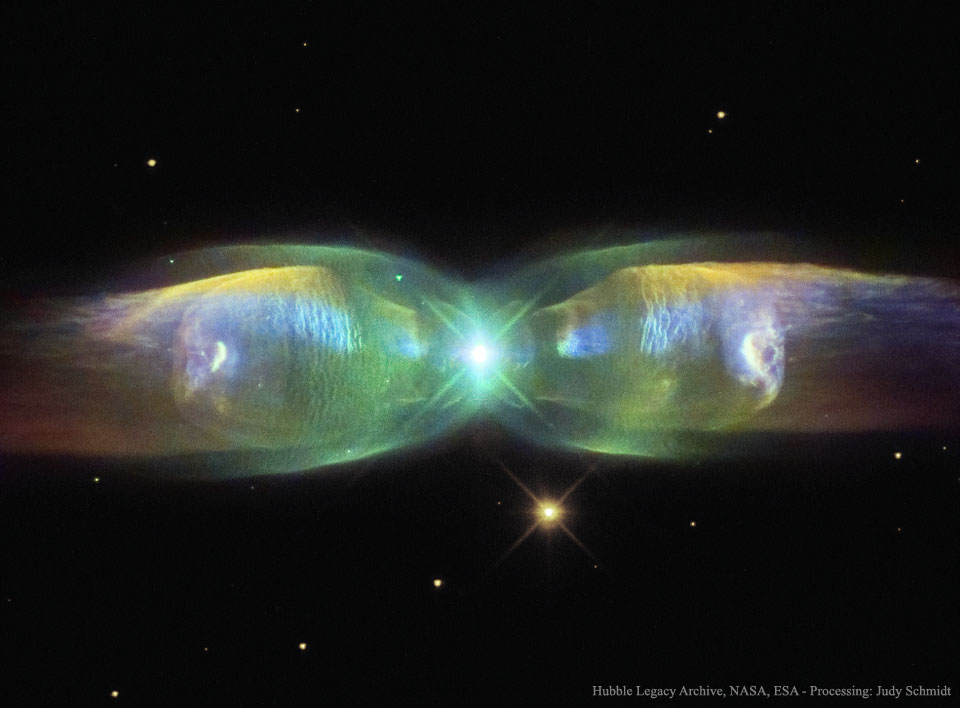 Image Credit: Hubble Legacy Archive, NASA, ESA - Processing: Judy Schmidt Explanation: Are stars better appreciated for their art after they die? Actually, stars usually create their most artistic displays as they die. In the case of low-mass stars like our Sun and M2-9 pictured above, the stars transform themselves from normal stars to white dwarfs by casting off their outer gaseous envelopes. The expended gas frequently forms an impressive display called a planetary nebula that fades gradually over thousands of years. M2-9, a butterfly planetary nebula 2100 light-years away shown in representative colors, has wings that tell a strange but incomplete tale. In the center, two stars orbit inside a gaseous disk 10 times the orbit of Pluto. The expelled envelope of the dying star breaks out from the disk creating the bipolar appearance. Much remains unknown about the physical processes that cause planetary nebulae.
__________________
όταν γράφεται η ιστορία της ζωής σου, μην αφήνεις κανέναν να κρατάει την πένα |
 |
#3589
|
 |
|
||||
|
Discover the cosmos! Each day a different image or photograph of our fascinating universe is featured, along with a brief explanation written by a professional astronomer. 2016 July 25 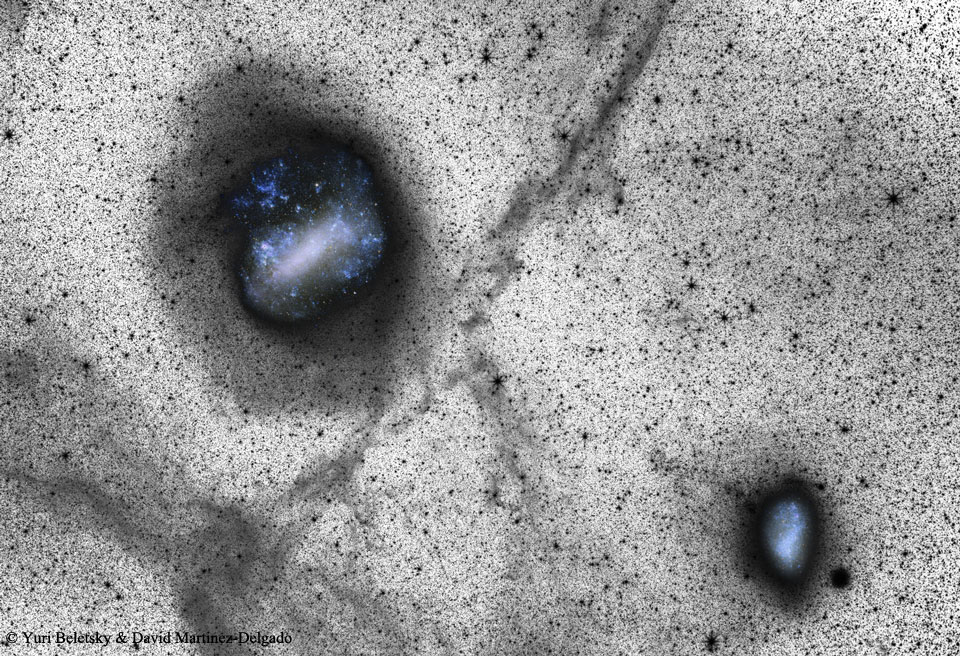 Image Credit & Copyright: Yuri Beletsky (Carnegie Las Campanas Observatory, TWAN) & David Martinez-Delgado (U. Heidelberg) Explanation: Did the two most famous satellite galaxies of our Milky Way Galaxy once collide? No one knows for sure, but a detailed inspection of deep images like that featured here give an indication that they have. Pictured, the Large Magellanic Cloud (LMC) is on the top left and the Small Magellanic Cloud (SMC) is on the bottom right. The surrounding field is monochrome color-inverted to highlight faint star streams, shown in gray. Perhaps surprisingly, the featured research-grade image was compiled with small telescopes to cover the large angular field -- nearly 40 degrees across. Much of the faint nebulosity is Galactic Cirrus clouds of thin dust in our own Galaxy, but a faint stream of stars does appear to be extending from the SMC toward the LMC. Also, stars surrounding the LMC appear asymmetrically distributed, indicating in simulations that they could well have been pulled off gravitationally in one or more collisions. Both the LMC and the SMC are visible to the unaided eye in southern skies. Future telescopic observations and computer simulations are sure to continue in a continuing effort to better understand the history of our Milky Way and its surroundings.
__________________
όταν γράφεται η ιστορία της ζωής σου, μην αφήνεις κανέναν να κρατάει την πένα |
 |
#3590
|
 |
|
||||
|
Discover the cosmos! Each day a different image or photograph of our fascinating universe is featured, along with a brief explanation written by a professional astronomer. 2016 July 26  Image Credit & Copyright: Sergio Montúfar; Acknowledgement: Planetario Ciudad de La Plata / CASLEO observatory Explanation: Can you find the comet? True, a careful eye can find thousands of stars, tens of constellations, four planets, three galaxies, and the central band of our Milky Way Galaxy -- all visible in the sky of this spectacular 180-degree panorama. Also, if you know what to look for, you can identify pervasive green airglow, an earthly cloud, the south celestial pole, and even a distant cluster of stars. But these are all easier to find than Comet 252P/LINEAR. The featured image, taken in el Leoncito National Park, Argentina in early April, also features the dome of the Jorge Sahade telescope on the hill on the far right. Have you found the comet yet? If so, good for you (it was the green spot on the left), but really the harder thing to find is Small Cloud of Magellan.
__________________
όταν γράφεται η ιστορία της ζωής σου, μην αφήνεις κανέναν να κρατάει την πένα |
 |
#3591
|
 |
|
||||
|
Discover the cosmos! Each day a different image or photograph of our fascinating universe is featured, along with a brief explanation written by a professional astronomer. 2016 July 27  Image Credit & Copyright: Dean Fournier; Inset: ESA/Hubble & NASA Explanation: M13 is one of the most prominent and best known globular clusters. Visible with binoculars in the constellation of Hercules, M13 is frequently one of the first objects found by curious sky gazers seeking celestials wonders beyond normal human vision. M13 is a colossal home to over 100,000 stars, spans over 150 light years across, lies over 20,000 light years distant, and is over 12 billion years old. At the 1974 dedication of Arecibo Observatory, a radio message about Earth was sent in the direction of M13. The featured image in HDR, taken through a small telescope, spans an angular size just larger than a full Moon, whereas the inset image, taken by Hubble Space Telescope, zooms in on the central 0.04 degrees.
__________________
όταν γράφεται η ιστορία της ζωής σου, μην αφήνεις κανέναν να κρατάει την πένα |
 |
#3592
|
 |
|
||||
|
Discover the cosmos! Each day a different image or photograph of our fascinating universe is featured, along with a brief explanation written by a professional astronomer. 2016 July 28  Image Credit & Copyright: ESA/Herschel/PACS, SPIRE/Hi-GAL Project Acknowledgment: G. Li Causi, IAPS/INAF Explanation: A now famous picture from the Hubble Space Telescope featured Pillars of Creation, star forming columns of cold gas and dust light-years long inside M16, the Eagle Nebula. This false-color composite image views the nearby stellar nursery using data from the Herschel Space Observatory's panoramic exploration of interstellar clouds along the plane of our Milky Way galaxy. Herschel's far infrared detectors record the emission from the region's cold dust directly. The famous pillars are included near the center of the scene. While the central group of hot young stars is not apparent at these infrared wavelengths, the stars' radiation and winds carve the shapes within the interstellar clouds. Scattered white spots are denser knots of gas and dust, clumps of material collapsing to form new stars. The Eagle Nebula is some 6,500 light-years distant, an easy target for binoculars or small telescopes in a nebula rich part of the sky toward the split constellation Serpens Cauda (the tail of the snake).
__________________
όταν γράφεται η ιστορία της ζωής σου, μην αφήνεις κανέναν να κρατάει την πένα |
| Οι παρακάτω χρήστες έχουν πει 'Ευχαριστώ' στον/στην Xenios για αυτό το μήνυμα: | ||
Easty (28-07-16) | ||
 |
#3593
|
 |
|
||||
|
Discover the cosmos! Each day a different image or photograph of our fascinating universe is featured, along with a brief explanation written by a professional astronomer. 2016 July 29 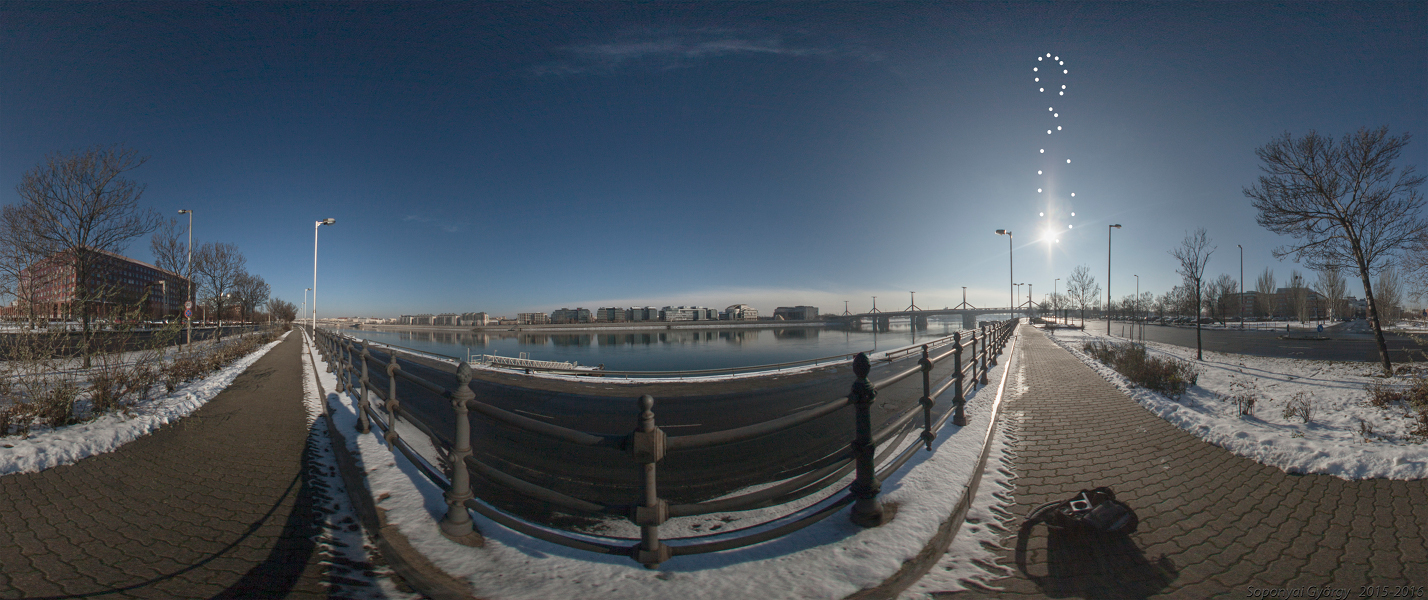 Image Credit & Copyright: György Soponyai Explanation: The Sun's annual waltz through planet Earth's sky forms a graceful curve known as an analemma. The analemma's figure 8 shape is tipped vertically at far right in this well-composed fisheye view from Budapest, Hungary. Captured at a chosen spot on the western bank of the Danube river, the Sun's position was recorded at 11:44 Central European Time on individual exposures over days spanning 2015 July 23 to 2016 July 4. Of course, on the northern summer solstice the Sun is at the top of the curve, but at the midpoints for the autumn and spring equinoxes. With snow on the ground, the photographer's shadow and equipment bag also appear in the base picture used for the composite panorama, taken on 2016 January 7. On that date, just after the winter solstice, the Sun was leaving the bottom of the beautiful curve over the blue Danube.
__________________
όταν γράφεται η ιστορία της ζωής σου, μην αφήνεις κανέναν να κρατάει την πένα |
| Οι παρακάτω χρήστες έχουν πει 'Ευχαριστώ' στον/στην Xenios για αυτό το μήνυμα: | ||
Easty (29-07-16) | ||
 |
#3594
|
 |
|
||||
|
Discover the cosmos! Each day a different image or photograph of our fascinating universe is featured, along with a brief explanation written by a professional astronomer. 2016 July 30 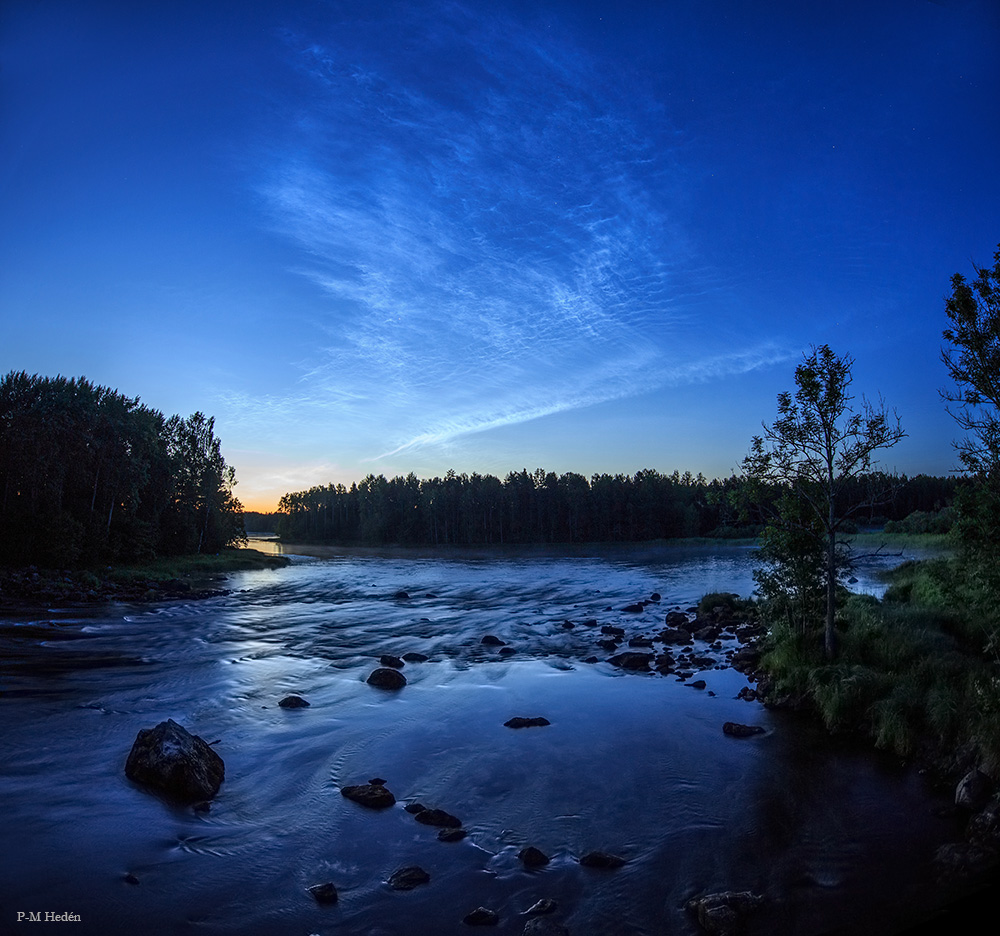 Image Credit & Copyright: P-M Hedén (Clear Skies, TWAN) Explanation: Sunlight ripples through a dark sky on this Swedish summer midnight as noctilucent or night shining clouds seem to imitate the river below. In fact, the seasonal clouds often appear at high latitudes in corresponding summer months. Also known as polar mesospheric clouds, they form as water vapor is driven into the cold upper atmosphere. Fine dust supplied by disintegrating meteors or volcanic ash provides sites where water vapor can condense, turning to ice at the cold temperatures in the mesosphere. Poised at the edge of space some 80 kilometers above, these icy clouds really do reflect sunlight toward the ground. They are visible here even though the Sun itself was below the horizon, as seen on July 16 from Sweden's Färnebofjärdens National Park.
__________________
όταν γράφεται η ιστορία της ζωής σου, μην αφήνεις κανέναν να κρατάει την πένα |
 |
#3595
|
 |
|
||||
|
Discover the cosmos! Each day a different image or photograph of our fascinating universe is featured, along with a brief explanation written by a professional astronomer. 2016 July 31 Video Credit: NASA's GSFC, SDO AIA Team Explanation: Filaments sometimes explode off the Sun. Featured, a huge filament had been seen hovering over the Sun's surface for over a week before it erupted late in 2010. The image sequence was taken by the Earth-orbiting Solar Dynamics Observatory (SDO) in one color of ultraviolet light. The explosion created a Coronal Mass Ejection that dispersed high energy plasma into the Solar System. This plasma cloud, though, missed the Earth and so did not cause auroras. The featured eruption depicted how widely separated areas of the Sun can sometimes act in unison. Explosions like this will likely become less common over the next few years as our Sun goes through a Solar Minimum in its surface magnetic activity.
__________________
όταν γράφεται η ιστορία της ζωής σου, μην αφήνεις κανέναν να κρατάει την πένα |
 |
#3596
|
 |
|
||||
|
Discover the cosmos! Each day a different image or photograph of our fascinating universe is featured, along with a brief explanation written by a professional astronomer. 2016 August 1  Image Credit: NASA/JPL-Caltech/Space Science Institute Explanation: What's behind Saturn? The first answer is the camera itself, perched on the Cassini spacecraft currently orbiting behind the planet with the most grand ring system in our Solar System. The unusual perspective places Cassini on the far side of Saturn from the Sun so that more than half of Saturn appears dark -- a perspective that no Earth-based observer could achieve. Behind Saturn, in the context of the featured infrared image, is Saturn's moon Tethys, visible as the small speck above the unusual hexagonal cloud pattern that encompasses Saturn's North Pole. Tethys actually orbits Saturn right in the ring plane, which places the 1000-km moon much farther from Cassini than the planet itself. Cassini has been studying Saturn and its moons for 12 years, but, unfortunately, its amazing mission will soon come to an end. In order to protect life that may exist on or inside Saturn's moons, the robotic spacecraft will be directed to crash into Saturn's thick atmosphere next September. Follow APOD on: Facebook, Google Plus, Instagram, or Twitter Tomorrow's picture: there, up in the air Πηγή
__________________
όταν γράφεται η ιστορία της ζωής σου, μην αφήνεις κανέναν να κρατάει την πένα |
 |
#3597
|
 |
|
||||
|
Discover the cosmos! Each day a different image or photograph of our fascinating universe is featured, along with a brief explanation written by a professional astronomer. 2016 August 2 Video Credit & Copyright: Matthew Holt Explanation: What's that crossing the sky? Although it looked a bit like a large meteor, it was actually the booster of a Chinese rocket returning to Earth after its launch two days earlier. On the night of July 27, the rocket component heated up and broke up into glowing pieces as it re-entered Earth's atmosphere. The path of the falling booster took it over several US states, moving west to east, from California to Utah. Space debris can usually be distinguished from meteors by its slow speed and expansive break up. The featured video was taken in front of the Provo City Library in Utah, which was coincidently occupied by over 100 people -- many with smartphones already out of their pockets playing Pokémon GO.
__________________
όταν γράφεται η ιστορία της ζωής σου, μην αφήνεις κανέναν να κρατάει την πένα |
 |
#3598
|
 |
|
||||
|
Discover the cosmos! Each day a different image or photograph of our fascinating universe is featured, along with a brief explanation written by a professional astronomer. 2016 August 3  Image Credit & Copyright: A. Garrett Evans; Rollover Annotation: Judy Schmidt Explanation: What if you climbed up on a rock and discovered the Universe? You can. Although others have noted much of it before, you can locate for yourself stars, planets, and even the plane of our Milky Way Galaxy. All you need is a dark clear sky -- the rock is optional. If you have a camera, you can further image faint nebulas, galaxies, and long filaments of interstellar dust. If you can process digital images, you can bring out faint features, highlight specific colors, and merge foreground and background images. In fact, an industrious astrophotographer has done all of these to create the presented picture. All of the component images were taken early last month on the same night within a few meters of each other. The picturesque setting was Sand Beach in Stonington, Maine, USA with the camera pointed south over Penobscot Bay.
__________________
όταν γράφεται η ιστορία της ζωής σου, μην αφήνεις κανέναν να κρατάει την πένα |
 |
#3599
|
 |
|
||||
|
Discover the cosmos! Each day a different image or photograph of our fascinating universe is featured, along with a brief explanation written by a professional astronomer. 2016 August 4 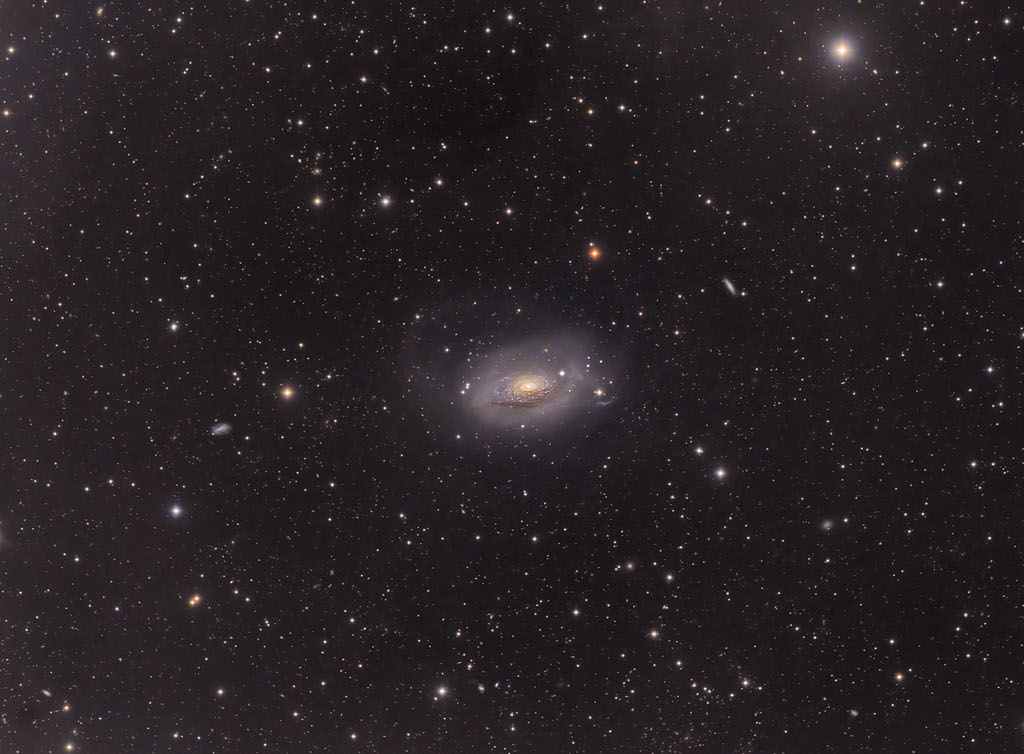 Image Credit & Copyright: Data - Deep Sky West, Processing - John Vermette Explanation: The Sunflower Galaxy blooms near the center of this wide field telescopic view. The scene spans about 2 degrees or 4 full moons on the sky toward the loyal constellation Canes Venatici. More formally known as Messier 63, the majestic island universe is nearly 100,000 light-years across, about the size of our own Milky Way Galaxy. Surrounding its bright yellowish core, sweeping spiral arms are streaked with cosmic dust lanes and dotted with star forming regions. A dominant member of a known galaxy group, M63 has faint, extended features that could be the the remains of dwarf satellite galaxies, evidence that large galaxies grow by accreting small ones. M63 shines across the electromagnetic spectrum and is thought to have undergone bursts of intense star formation.
__________________
όταν γράφεται η ιστορία της ζωής σου, μην αφήνεις κανέναν να κρατάει την πένα |
 |
#3600
|
 |
|
||||
|
Discover the cosmos! Each day a different image or photograph of our fascinating universe is featured, along with a brief explanation written by a professional astronomer. 2016 August 5  Image Credit & Copyright: Apollo 15, USGS, NASA Explanation: On July 31, 1971, Apollo 15 astronauts Jim Iwrin and Dave Scott deployed the first Lunar Roving Vehicle on the Moon. Using it to explore their Hadley-Apennine landing site they spent nearly three days on the Moon while Al Worden orbited above. This digitally stitched panorama shows Scott examining a boulder on the slope of 3.5 kilometer high Mons Hadley Delta to the left of their electric-powered, four-wheel drive vehicle. The sun at his back, Irwin casts the strong shadow to the rover's right. The panoramic view extends farther right to the sunward direction, over Hadley Rille and lunar terrain, revealed in harsh, unfiltered sunlight. In total, the rover traversed 28 kilometers (17 miles) on the lunar surface. The Apollo 15 mission returned about 76 kilograms of moon rocks to planet Earth.
__________________
όταν γράφεται η ιστορία της ζωής σου, μην αφήνεις κανέναν να κρατάει την πένα |
| Οι παρακάτω χρήστες έχουν πει 'Ευχαριστώ' στον/στην Xenios για αυτό το μήνυμα: | ||
Easty (05-08-16) | ||
 |
| Συνδεδεμένοι χρήστες που διαβάζουν αυτό το θέμα: 1 (0 μέλη και 1 επισκέπτες) | |
|
|